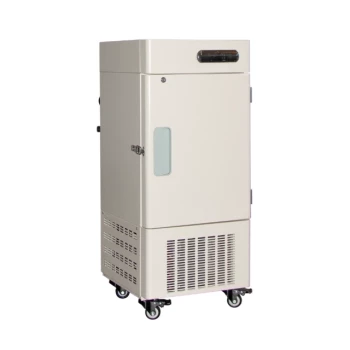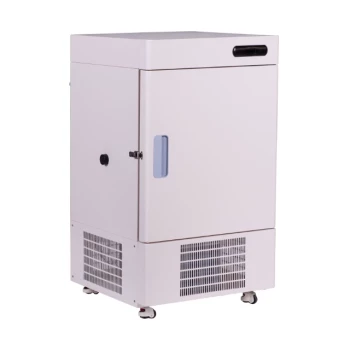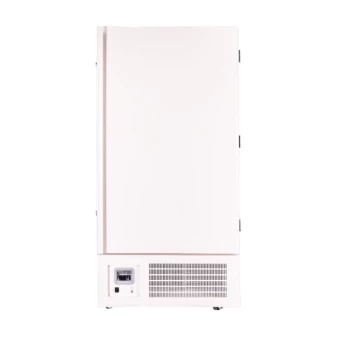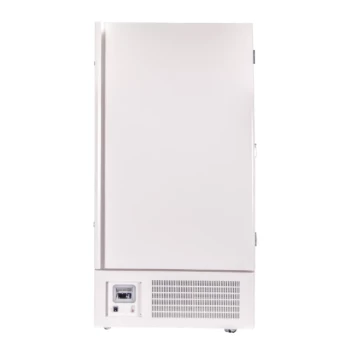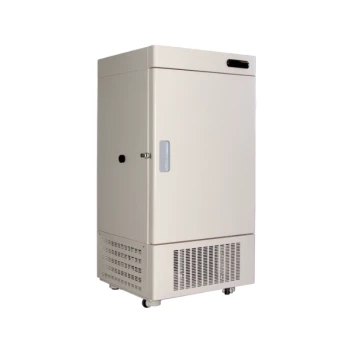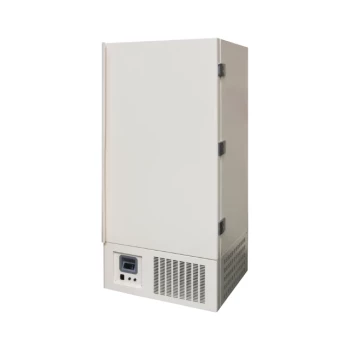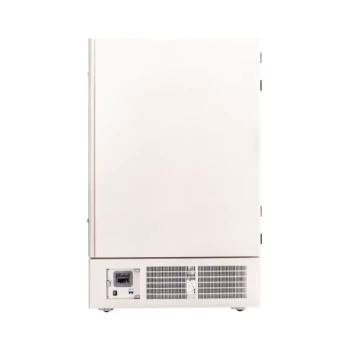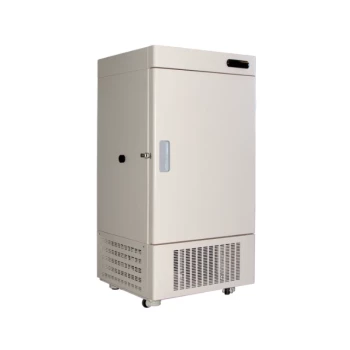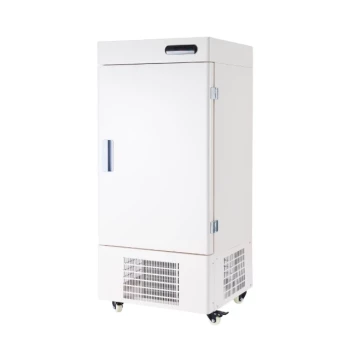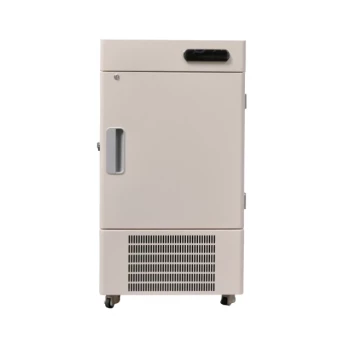At their core, ultra-low temperature (ULT) freezers are used in any application where the long-term biological or chemical integrity of a sample is non-negotiable. These essential devices are found across biomedical research, clinical medicine, pharmaceuticals, and even industrial testing, serving as the primary defense against sample degradation. Their function is to preserve everything from vaccines and DNA to forensic evidence and high-performance industrial components.
The fundamental purpose of a ULT freezer is not merely cold storage; it is to effectively stop time at a molecular level. By driving temperatures to -86°C and below, these units halt the enzymatic and chemical processes that would otherwise degrade invaluable samples, ensuring their stability for future analysis or use.

The Critical Role in Biomedical and Clinical Settings
The vast majority of ULT freezer applications are in fields that handle delicate biological materials. In these contexts, sample viability is directly tied to the success of research, patient outcomes, and public health initiatives.
Preserving Foundational Research Materials
In genetics, molecular biology, and drug discovery, ULT freezers are indispensable. They store the fundamental building blocks of modern research.
This includes sensitive materials like DNA, RNA, proteins, enzymes, and cell lines. At standard freezer temperatures, these samples would slowly degrade, rendering long-term studies impossible and invalidating results.
Safeguarding Vaccines and Pharmaceuticals
Complex biologicals, especially modern vaccines like certain mRNA COVID-19 vaccines, require ultra-low temperatures to maintain their structure and efficacy.
Without precise cold chain management, these life-saving products can quickly become inert. ULT freezers ensure they remain potent from production to administration.
Securing Blood Products and Patient Tissues
Hospitals, blood banks, and clinical laboratories rely on ULT freezers for the long-term storage of critical human-derived materials.
This includes blood plasma, tissues for transplant or research, and stem cells. For biobanks and research institutes, these freezers create invaluable repositories of samples that can be studied for years or decades.
Applications Beyond the Medical Field
While dominated by biomedicine, the need to halt degradation at extreme cold temperatures extends to other highly specialized industries.
Ensuring Long-Term Forensic Viability
Forensic laboratories use ULT freezers to preserve biological evidence for long-term storage.
Storing materials like tissue samples or DNA evidence at ultra-low temperatures prevents decomposition, ensuring the evidence remains intact and viable for future testing as new analytical technologies become available.
Industrial and Materials Testing
Manufacturers of electronics, automotive parts, or aerospace components must validate their products' reliability under extreme conditions.
ULT freezers are used to simulate harsh environments, such as arctic temperatures, to stress-test parts and ensure they will not fail in critical applications.
Environmental and Agricultural Science
Research into ecology, agriculture, and biodiversity often requires the long-term preservation of unique biological samples.
ULT freezers store plant seeds, insect specimens, and unique bacterial cultures for future study, helping to preserve genetic diversity and advance scientific understanding.
Understanding the Trade-offs: Why Not a Standard Freezer?
The decision to use a ULT freezer is driven by necessity, not preference. Understanding the key distinction from a standard freezer clarifies its critical role.
The Problem of Degradation
A standard laboratory freezer operates around -20°C. At this temperature, biological activity is slowed, but it is not stopped. Enzymes can still function, and chemical reactions will continue to degrade samples over time.
The Requirement for Absolute Stability
For a research study that may last a decade or for a one-of-a-kind patient sample, "slowed" degradation is unacceptable. ULT freezers, operating at -80°C or below, effectively halt biological activity, providing the long-term stability required for irreplaceable assets.
The Cost of Certainty
ULT freezers consume significantly more energy and have higher maintenance costs than standard units. They are an expensive tool reserved for applications where the cost of a lost sample—whether in research time, monetary value, or patient impact—is far greater than the cost of operation.
Making the Right Choice for Your Goal
The need for a ULT freezer is defined entirely by the stability requirements of the material being stored.
- If your primary focus is cutting-edge biological research: A ULT freezer is mandatory to preserve the integrity of DNA, RNA, proteins, and cell lines for reproducible, long-term studies.
- If your primary focus is clinical operations or public health: ULTs are non-negotiable for storing sensitive vaccines, blood plasma, and critical patient tissues to ensure efficacy and patient safety.
- If your primary focus is industrial reliability or forensic science: A ULT freezer is the only way to either simulate extreme cold environments or guarantee the long-term preservation of invaluable evidence.
Ultimately, an ultra-low freezer is an investment in certainty, protecting irreplaceable assets against the inevitable decay of time.
Summary Table:
| Application Area | Key Materials Stored | Purpose |
|---|---|---|
| Biomedical Research | DNA, RNA, Proteins, Cell Lines | Preserve integrity for long-term, reproducible studies. |
| Clinical & Pharmaceutical | Vaccines, Blood Plasma, Tissues | Ensure patient safety and product efficacy. |
| Forensic Science | DNA Evidence, Tissue Samples | Maintain evidence viability for future analysis. |
| Industrial Testing | Electronics, Automotive Parts | Simulate extreme cold environments for reliability testing. |
| Environmental Science | Plant Seeds, Bacterial Cultures | Preserve genetic diversity for future research. |
Unsure if your lab needs an ultra-low freezer? The integrity of your sensitive samples is paramount. KINTEK specializes in lab equipment and consumables, serving laboratory needs. Our experts can help you determine the right storage solution to protect your irreplaceable research materials, clinical samples, or industrial components. Ensure absolute sample stability—contact our team today for a personalized consultation.
Visual Guide

Related Products
- 28L Compact Upright Ultra Low Temperature Freezer for Laboratory
- 108L Vertical Ultra Low Temperature ULT Freezer
- 508L Advanced Vertical Ultra Low Temperature Freezer for Critical Laboratory Storage
- 408L Advanced Vertical Laboratory Ultra Low Temperature Freezer for Critical Research Material Preservation
- 708L Ultra Low Temperature Freezer High Performance Laboratory Freezer
People Also Ask
- What factors should be considered when selecting an ultra-low temperature freezer? Ensure Sample Integrity and Long-Term Value
- What are ultra low temperature freezers used for? Preserving Critical Biological Samples for Decades
- What temperature range do Ultra-Low Temperature freezers maintain? The -80°C Standard for Sample Integrity
- What advantages do ultra-low temperature freezers offer? Ensure Long-Term Sample Integrity and Reliability
- What are the common designs of ultra-low temperature freezers? Upright vs. Chest Models for Your Lab
